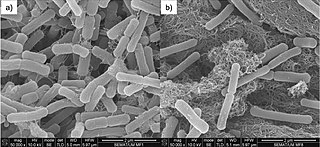Related Research Articles

Bacilli is a taxonomic class of bacteria that includes two orders, Bacillales and Lactobacillales, which contain several well-known pathogens such as Bacillus anthracis. Bacilli are almost exclusively gram-positive bacteria.
Mollicutes is a class of bacteria distinguished by the absence of a cell wall. The word "Mollicutes" is derived from the Latin mollis, and cutis. Individuals are very small, typically only 0.2–0.3 μm in size and have a very small genome size. They vary in form, although most have sterols that make the cell membrane somewhat more rigid. Many are able to move about through gliding, but members of the genus Spiroplasma are helical and move by twisting. The best-known genus in the Mollicutes is Mycoplasma. Colonies show the typical "fried-egg" appearance.
Rhodobacterales are an order of the Alphaproteobacteria.
The Deferribacteraceae are a family of gram-negative bacteria which make energy by anaerobic respiration.
In taxonomy, Ahrensia is a genus of the Hyphomicrobiales. Ahrensia is named after the German microbiologist R. Ahrens. The cells are rod-shaped and motile. They are strictly aerobic.
In taxonomy, Albidovulum is a genus of the Rhodobacteraceae.
In taxonomy, Rhodobacter is a genus of the Rhodobacteraceae. The most famous species of Rhodobacter are Rhodobacter sphaeroides and Rhodobacter capsulatus, which are used as model organisms to study bacterial photosynthesis.
In taxonomy, Rhodothalassium is a genus of the Rhodobacteraceae. Up to now there is only one species of this genus known.
In taxonomy, Haematobacter is a genus of the Rhodobacteraceae.
In taxonomy, Jannaschia is a genus of the Rhodobacteraceae.
In taxonomy, Loktanella is a genus of the Rhodobacteraceae.
In taxonomy, Maritimibacter is a genus of the Rhodobacteraceae.
In taxonomy, Methylarcula is a genus of the Rhodobacteraceae.
In taxonomy, Pseudorhodobacter is a genus of the Rhodobacteraceae.
In taxonomy, Roseibium is a genus of the Hyphomicrobiales.
Roseovarius is a genus of bacteria in the family Roseobacteraceae.
In taxonomy, Salipiger is a genus of the Rhodobacteraceae.
In taxonomy, Stappia is a genus of the Hyphomicrobiales. Some members of the genus oxidize carbon monoxide (CO) aerobically. Stappia indica is a diatom associated bacterium which is known to inhibit the growth of diatoms such as Thalassiosira pseudonana.

Methanobacterium is a genus of the Methanobacteriaceae family of Archaea. Despite the name, this genus belongs not to the bacterial domain but the archaeal domain. Methanobacterium are nonmotile and live without oxygen as anaerobic bacterium. They do not create endospores when nutrients are limited. Some members of this genus can use formate to reduce methane; others live exclusively through the reduction of carbon dioxide with hydrogen. They are ubiquitous in some hot, low-oxygen environments, such as anaerobic digestors, their waste water, and hot springs.
Rhodovulum sulfidophilum is a gram-negative purple nonsulfur bacteria. The cells are rod-shaped, and range in size from 0.6 to 0.9 μm wide and 0.9 to 2.0 μm long, and have a polar flagella. These cells reproduce asexually by binary fission. This bacterium can grow anaerobically when light is present, or aerobically (chemoheterotrophic) under dark conditions. It contains the photosynthetic pigments bacteriochlorophyll a and of carotenoids.
References
- ↑ See the NCBI webpage on Rhodovulum. Data extracted from the "NCBI taxonomy resources". National Center for Biotechnology Information . Retrieved 2007-03-19.